Stockland Units Auditing and Ethics Report: 2019 Analysis & Review
VerifiedAdded on 2023/04/21
|15
|2750
|222
Report
AI Summary
This report provides an in-depth analysis of the auditing and ethics of Stockland Units, focusing on the 2018 financial year. The report begins with an executive summary, followed by an introduction that outlines the scope of the analysis, which includes an assessment of the level of materiality, a preliminary review of the company's financial position, and an interpretation of its cash flow statements. The analysis of materiality considers both quantitative and qualitative factors, including financial risks and the impact of estimations on the company's financial statements. The preliminary review examines the current and quick ratios, as well as the debt-to-equity ratio. Finally, the cash flow interpretation assesses the company's cash inflows and outflows from operating, investing, and financing activities. The report concludes with a summary of findings and references to support the analysis.

Auditing and Ethics
2019
2019
Paraphrase This Document
Need a fresh take? Get an instant paraphrase of this document with our AI Paraphraser
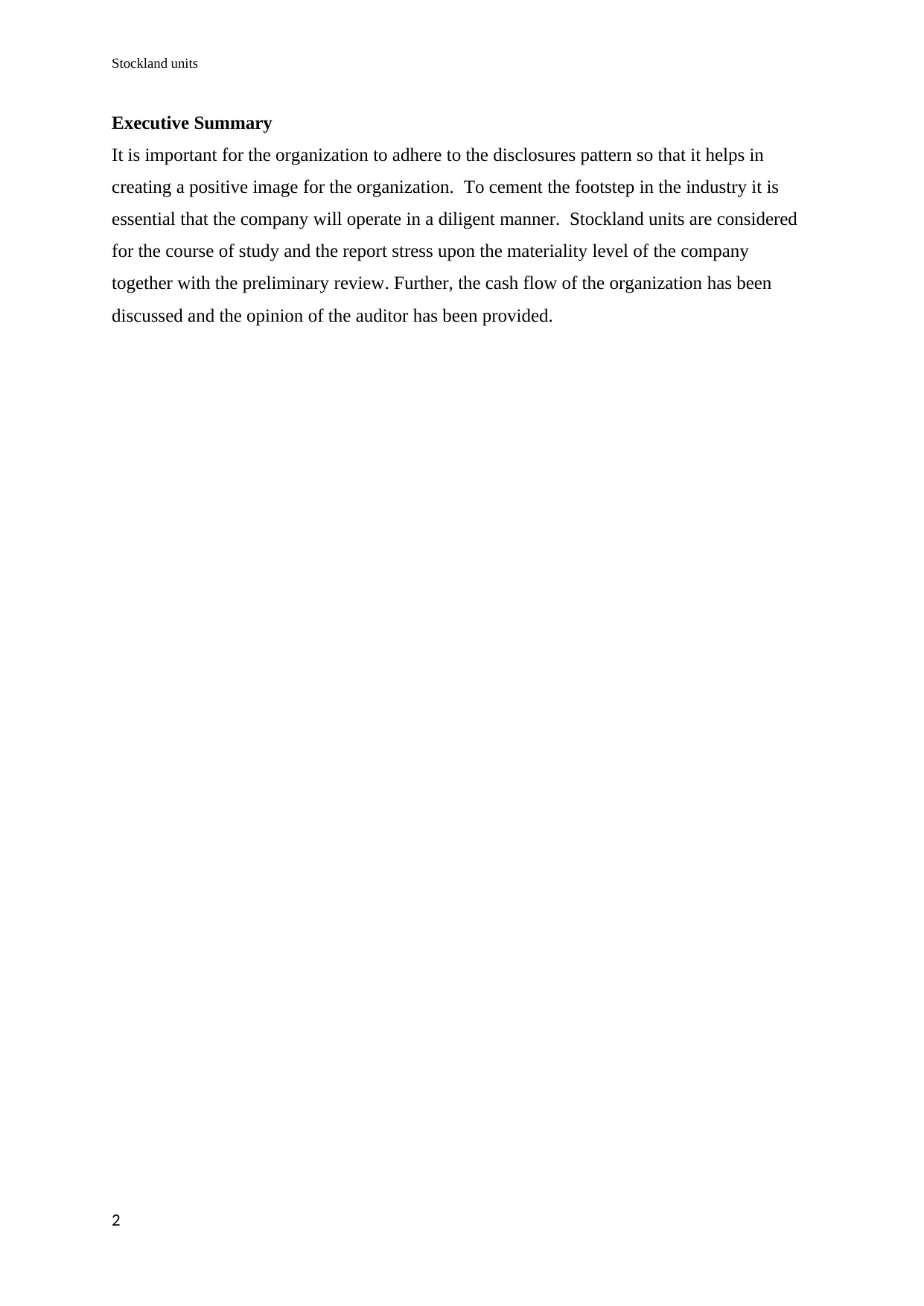
Stockland units
Executive Summary
It is important for the organization to adhere to the disclosures pattern so that it helps in
creating a positive image for the organization. To cement the footstep in the industry it is
essential that the company will operate in a diligent manner. Stockland units are considered
for the course of study and the report stress upon the materiality level of the company
together with the preliminary review. Further, the cash flow of the organization has been
discussed and the opinion of the auditor has been provided.
2
Executive Summary
It is important for the organization to adhere to the disclosures pattern so that it helps in
creating a positive image for the organization. To cement the footstep in the industry it is
essential that the company will operate in a diligent manner. Stockland units are considered
for the course of study and the report stress upon the materiality level of the company
together with the preliminary review. Further, the cash flow of the organization has been
discussed and the opinion of the auditor has been provided.
2
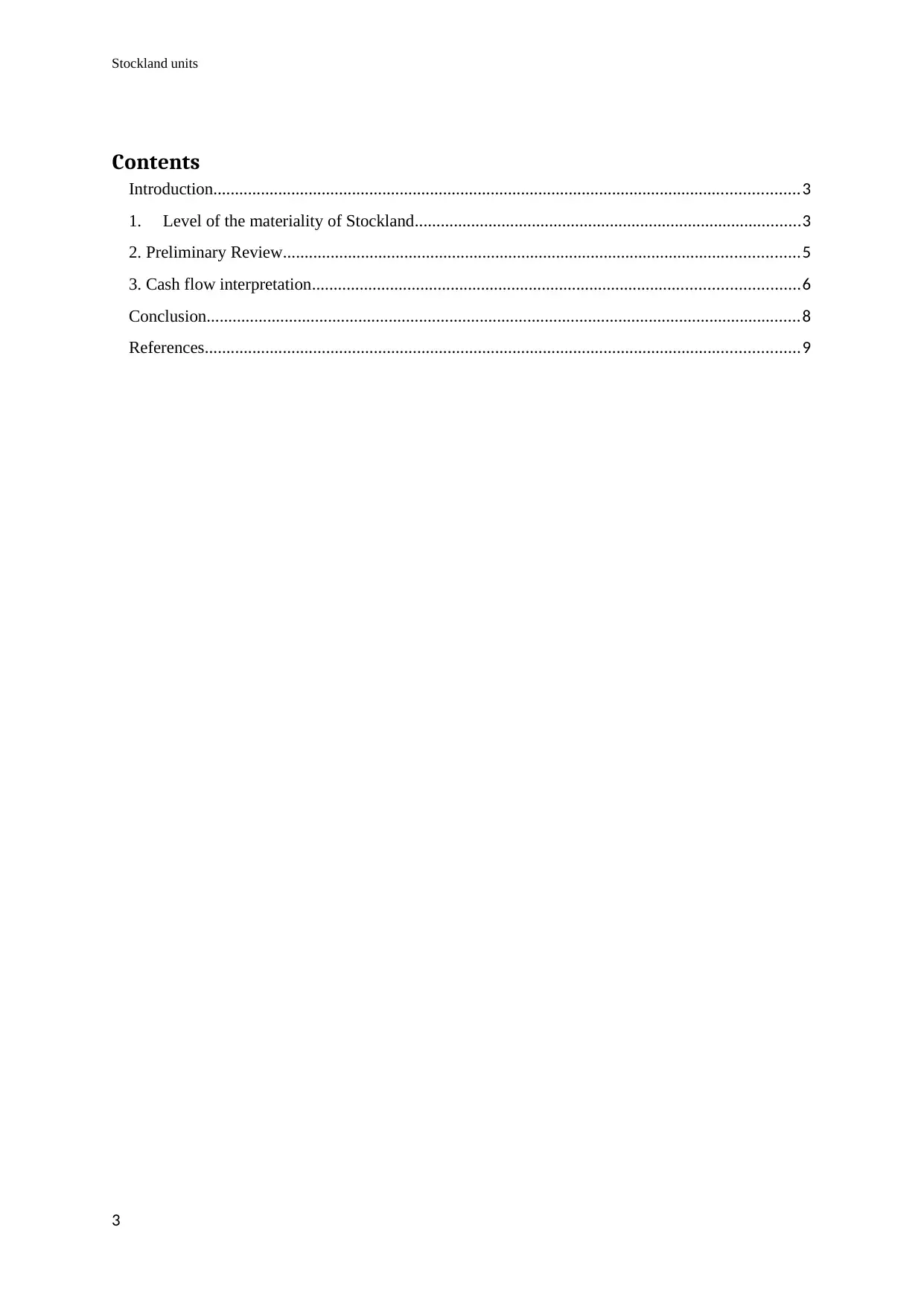
Stockland units
Contents
Introduction.......................................................................................................................................3
1. Level of the materiality of Stockland.........................................................................................3
2. Preliminary Review.......................................................................................................................5
3. Cash flow interpretation................................................................................................................6
Conclusion.........................................................................................................................................8
References.........................................................................................................................................9
3
Contents
Introduction.......................................................................................................................................3
1. Level of the materiality of Stockland.........................................................................................3
2. Preliminary Review.......................................................................................................................5
3. Cash flow interpretation................................................................................................................6
Conclusion.........................................................................................................................................8
References.........................................................................................................................................9
3
⊘ This is a preview!⊘
Do you want full access?
Subscribe today to unlock all pages.

Trusted by 1+ million students worldwide
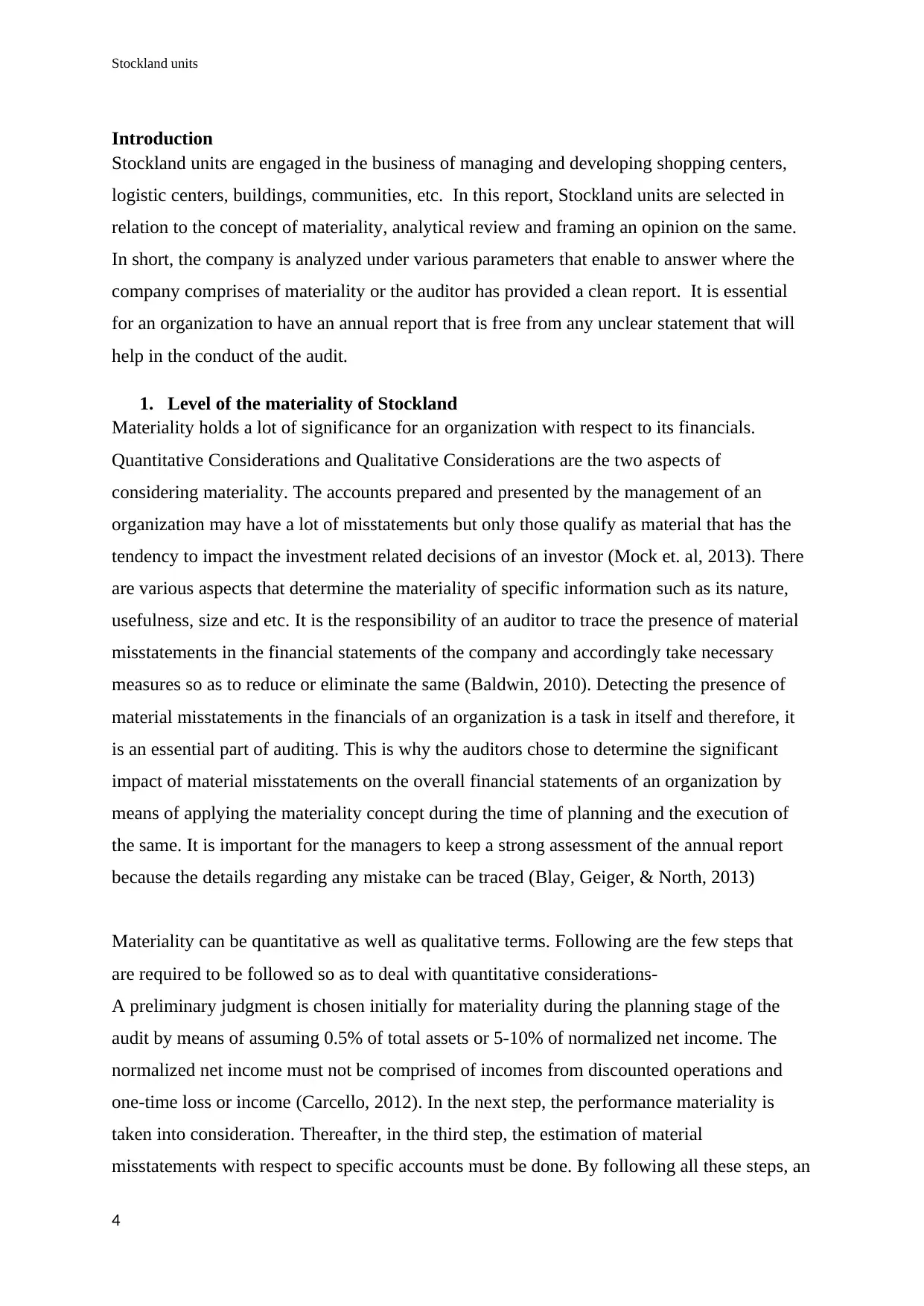
Stockland units
Introduction
Stockland units are engaged in the business of managing and developing shopping centers,
logistic centers, buildings, communities, etc. In this report, Stockland units are selected in
relation to the concept of materiality, analytical review and framing an opinion on the same.
In short, the company is analyzed under various parameters that enable to answer where the
company comprises of materiality or the auditor has provided a clean report. It is essential
for an organization to have an annual report that is free from any unclear statement that will
help in the conduct of the audit.
1. Level of the materiality of Stockland
Materiality holds a lot of significance for an organization with respect to its financials.
Quantitative Considerations and Qualitative Considerations are the two aspects of
considering materiality. The accounts prepared and presented by the management of an
organization may have a lot of misstatements but only those qualify as material that has the
tendency to impact the investment related decisions of an investor (Mock et. al, 2013). There
are various aspects that determine the materiality of specific information such as its nature,
usefulness, size and etc. It is the responsibility of an auditor to trace the presence of material
misstatements in the financial statements of the company and accordingly take necessary
measures so as to reduce or eliminate the same (Baldwin, 2010). Detecting the presence of
material misstatements in the financials of an organization is a task in itself and therefore, it
is an essential part of auditing. This is why the auditors chose to determine the significant
impact of material misstatements on the overall financial statements of an organization by
means of applying the materiality concept during the time of planning and the execution of
the same. It is important for the managers to keep a strong assessment of the annual report
because the details regarding any mistake can be traced (Blay, Geiger, & North, 2013)
Materiality can be quantitative as well as qualitative terms. Following are the few steps that
are required to be followed so as to deal with quantitative considerations-
A preliminary judgment is chosen initially for materiality during the planning stage of the
audit by means of assuming 0.5% of total assets or 5-10% of normalized net income. The
normalized net income must not be comprised of incomes from discounted operations and
one-time loss or income (Carcello, 2012). In the next step, the performance materiality is
taken into consideration. Thereafter, in the third step, the estimation of material
misstatements with respect to specific accounts must be done. By following all these steps, an
4
Introduction
Stockland units are engaged in the business of managing and developing shopping centers,
logistic centers, buildings, communities, etc. In this report, Stockland units are selected in
relation to the concept of materiality, analytical review and framing an opinion on the same.
In short, the company is analyzed under various parameters that enable to answer where the
company comprises of materiality or the auditor has provided a clean report. It is essential
for an organization to have an annual report that is free from any unclear statement that will
help in the conduct of the audit.
1. Level of the materiality of Stockland
Materiality holds a lot of significance for an organization with respect to its financials.
Quantitative Considerations and Qualitative Considerations are the two aspects of
considering materiality. The accounts prepared and presented by the management of an
organization may have a lot of misstatements but only those qualify as material that has the
tendency to impact the investment related decisions of an investor (Mock et. al, 2013). There
are various aspects that determine the materiality of specific information such as its nature,
usefulness, size and etc. It is the responsibility of an auditor to trace the presence of material
misstatements in the financial statements of the company and accordingly take necessary
measures so as to reduce or eliminate the same (Baldwin, 2010). Detecting the presence of
material misstatements in the financials of an organization is a task in itself and therefore, it
is an essential part of auditing. This is why the auditors chose to determine the significant
impact of material misstatements on the overall financial statements of an organization by
means of applying the materiality concept during the time of planning and the execution of
the same. It is important for the managers to keep a strong assessment of the annual report
because the details regarding any mistake can be traced (Blay, Geiger, & North, 2013)
Materiality can be quantitative as well as qualitative terms. Following are the few steps that
are required to be followed so as to deal with quantitative considerations-
A preliminary judgment is chosen initially for materiality during the planning stage of the
audit by means of assuming 0.5% of total assets or 5-10% of normalized net income. The
normalized net income must not be comprised of incomes from discounted operations and
one-time loss or income (Carcello, 2012). In the next step, the performance materiality is
taken into consideration. Thereafter, in the third step, the estimation of material
misstatements with respect to specific accounts must be done. By following all these steps, an
4
Paraphrase This Document
Need a fresh take? Get an instant paraphrase of this document with our AI Paraphraser
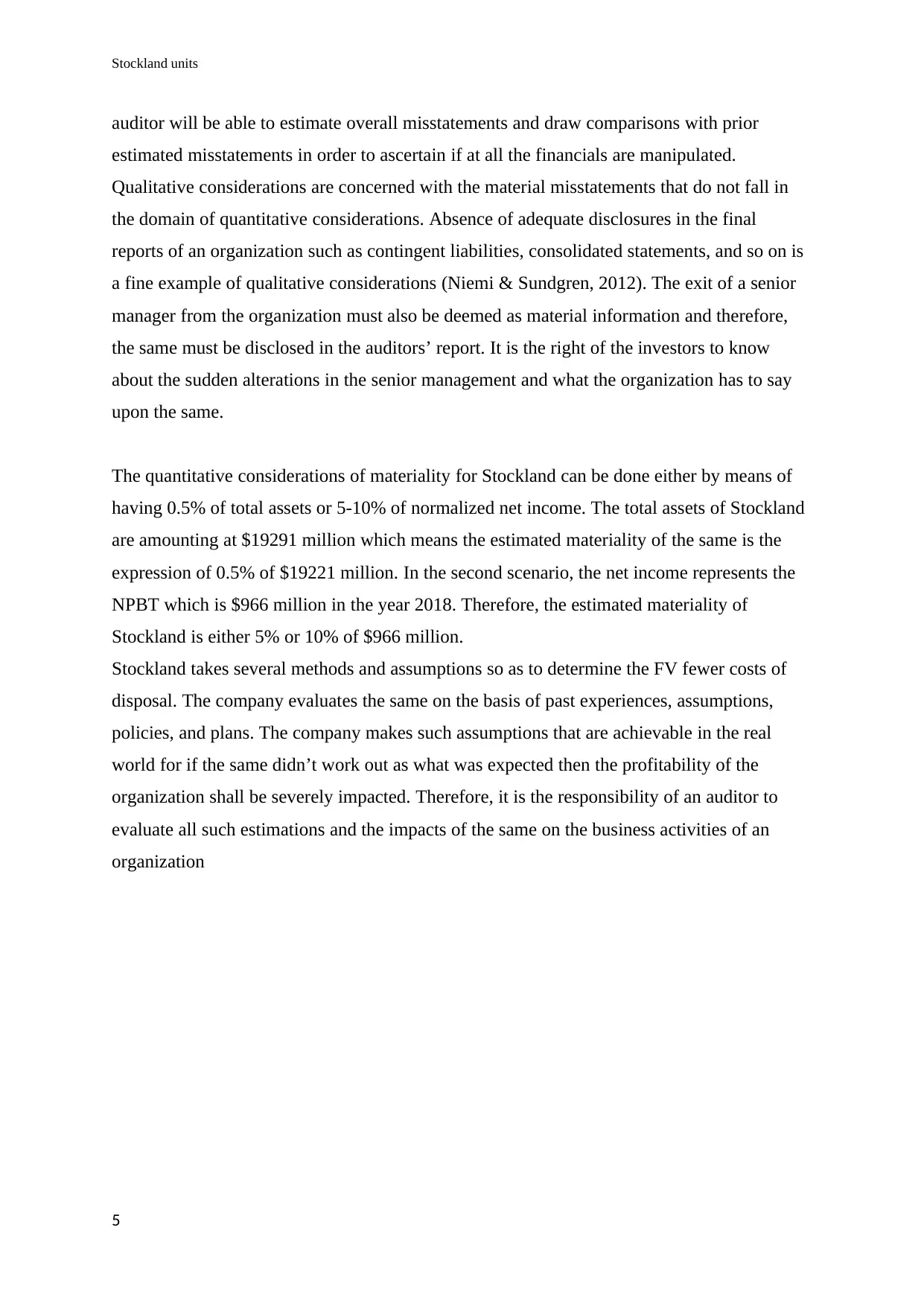
Stockland units
auditor will be able to estimate overall misstatements and draw comparisons with prior
estimated misstatements in order to ascertain if at all the financials are manipulated.
Qualitative considerations are concerned with the material misstatements that do not fall in
the domain of quantitative considerations. Absence of adequate disclosures in the final
reports of an organization such as contingent liabilities, consolidated statements, and so on is
a fine example of qualitative considerations (Niemi & Sundgren, 2012). The exit of a senior
manager from the organization must also be deemed as material information and therefore,
the same must be disclosed in the auditors’ report. It is the right of the investors to know
about the sudden alterations in the senior management and what the organization has to say
upon the same.
The quantitative considerations of materiality for Stockland can be done either by means of
having 0.5% of total assets or 5-10% of normalized net income. The total assets of Stockland
are amounting at $19291 million which means the estimated materiality of the same is the
expression of 0.5% of $19221 million. In the second scenario, the net income represents the
NPBT which is $966 million in the year 2018. Therefore, the estimated materiality of
Stockland is either 5% or 10% of $966 million.
Stockland takes several methods and assumptions so as to determine the FV fewer costs of
disposal. The company evaluates the same on the basis of past experiences, assumptions,
policies, and plans. The company makes such assumptions that are achievable in the real
world for if the same didn’t work out as what was expected then the profitability of the
organization shall be severely impacted. Therefore, it is the responsibility of an auditor to
evaluate all such estimations and the impacts of the same on the business activities of an
organization
5
auditor will be able to estimate overall misstatements and draw comparisons with prior
estimated misstatements in order to ascertain if at all the financials are manipulated.
Qualitative considerations are concerned with the material misstatements that do not fall in
the domain of quantitative considerations. Absence of adequate disclosures in the final
reports of an organization such as contingent liabilities, consolidated statements, and so on is
a fine example of qualitative considerations (Niemi & Sundgren, 2012). The exit of a senior
manager from the organization must also be deemed as material information and therefore,
the same must be disclosed in the auditors’ report. It is the right of the investors to know
about the sudden alterations in the senior management and what the organization has to say
upon the same.
The quantitative considerations of materiality for Stockland can be done either by means of
having 0.5% of total assets or 5-10% of normalized net income. The total assets of Stockland
are amounting at $19291 million which means the estimated materiality of the same is the
expression of 0.5% of $19221 million. In the second scenario, the net income represents the
NPBT which is $966 million in the year 2018. Therefore, the estimated materiality of
Stockland is either 5% or 10% of $966 million.
Stockland takes several methods and assumptions so as to determine the FV fewer costs of
disposal. The company evaluates the same on the basis of past experiences, assumptions,
policies, and plans. The company makes such assumptions that are achievable in the real
world for if the same didn’t work out as what was expected then the profitability of the
organization shall be severely impacted. Therefore, it is the responsibility of an auditor to
evaluate all such estimations and the impacts of the same on the business activities of an
organization
5
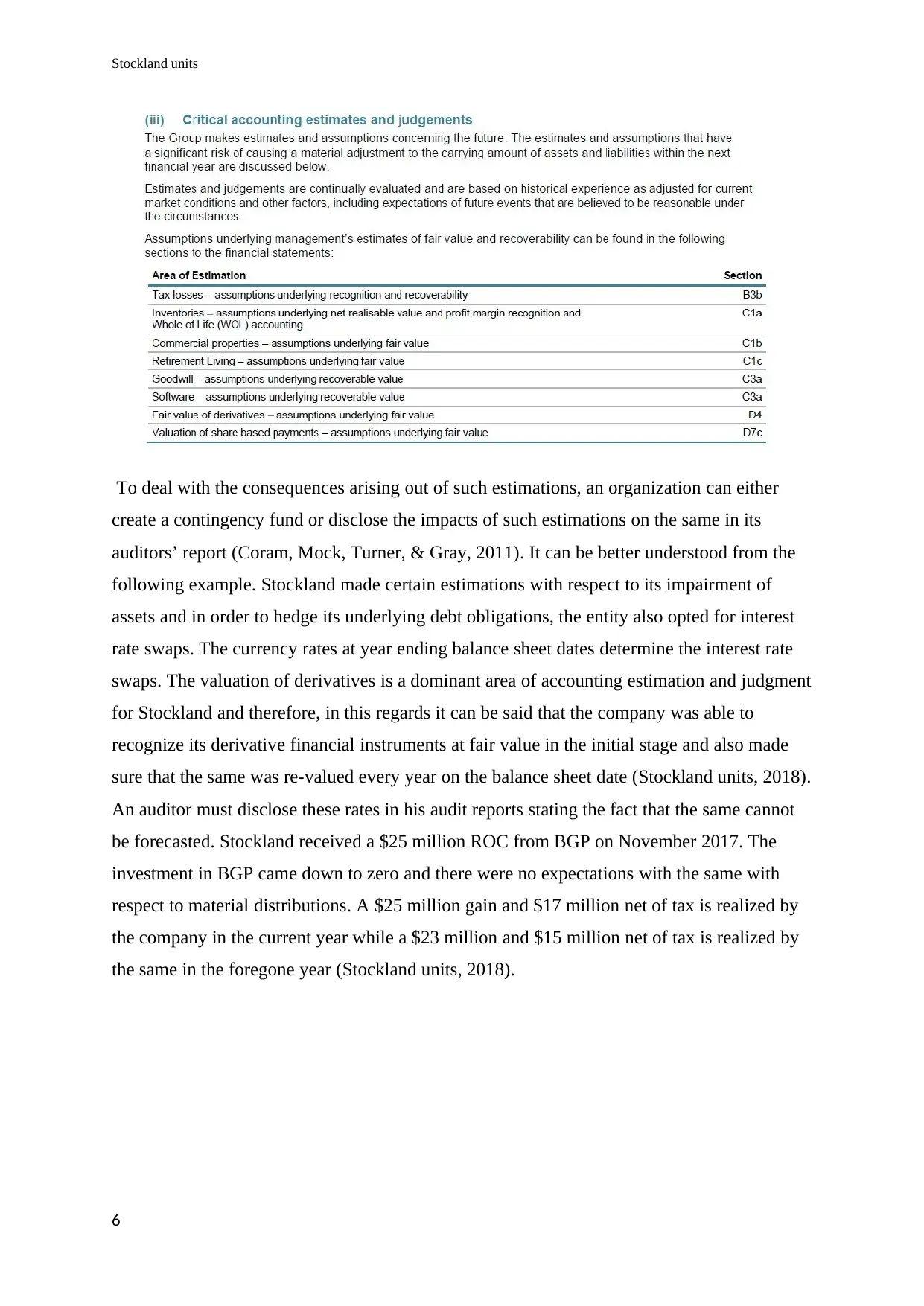
Stockland units
To deal with the consequences arising out of such estimations, an organization can either
create a contingency fund or disclose the impacts of such estimations on the same in its
auditors’ report (Coram, Mock, Turner, & Gray, 2011). It can be better understood from the
following example. Stockland made certain estimations with respect to its impairment of
assets and in order to hedge its underlying debt obligations, the entity also opted for interest
rate swaps. The currency rates at year ending balance sheet dates determine the interest rate
swaps. The valuation of derivatives is a dominant area of accounting estimation and judgment
for Stockland and therefore, in this regards it can be said that the company was able to
recognize its derivative financial instruments at fair value in the initial stage and also made
sure that the same was re-valued every year on the balance sheet date (Stockland units, 2018).
An auditor must disclose these rates in his audit reports stating the fact that the same cannot
be forecasted. Stockland received a $25 million ROC from BGP on November 2017. The
investment in BGP came down to zero and there were no expectations with the same with
respect to material distributions. A $25 million gain and $17 million net of tax is realized by
the company in the current year while a $23 million and $15 million net of tax is realized by
the same in the foregone year (Stockland units, 2018).
6
To deal with the consequences arising out of such estimations, an organization can either
create a contingency fund or disclose the impacts of such estimations on the same in its
auditors’ report (Coram, Mock, Turner, & Gray, 2011). It can be better understood from the
following example. Stockland made certain estimations with respect to its impairment of
assets and in order to hedge its underlying debt obligations, the entity also opted for interest
rate swaps. The currency rates at year ending balance sheet dates determine the interest rate
swaps. The valuation of derivatives is a dominant area of accounting estimation and judgment
for Stockland and therefore, in this regards it can be said that the company was able to
recognize its derivative financial instruments at fair value in the initial stage and also made
sure that the same was re-valued every year on the balance sheet date (Stockland units, 2018).
An auditor must disclose these rates in his audit reports stating the fact that the same cannot
be forecasted. Stockland received a $25 million ROC from BGP on November 2017. The
investment in BGP came down to zero and there were no expectations with the same with
respect to material distributions. A $25 million gain and $17 million net of tax is realized by
the company in the current year while a $23 million and $15 million net of tax is realized by
the same in the foregone year (Stockland units, 2018).
6
⊘ This is a preview!⊘
Do you want full access?
Subscribe today to unlock all pages.

Trusted by 1+ million students worldwide
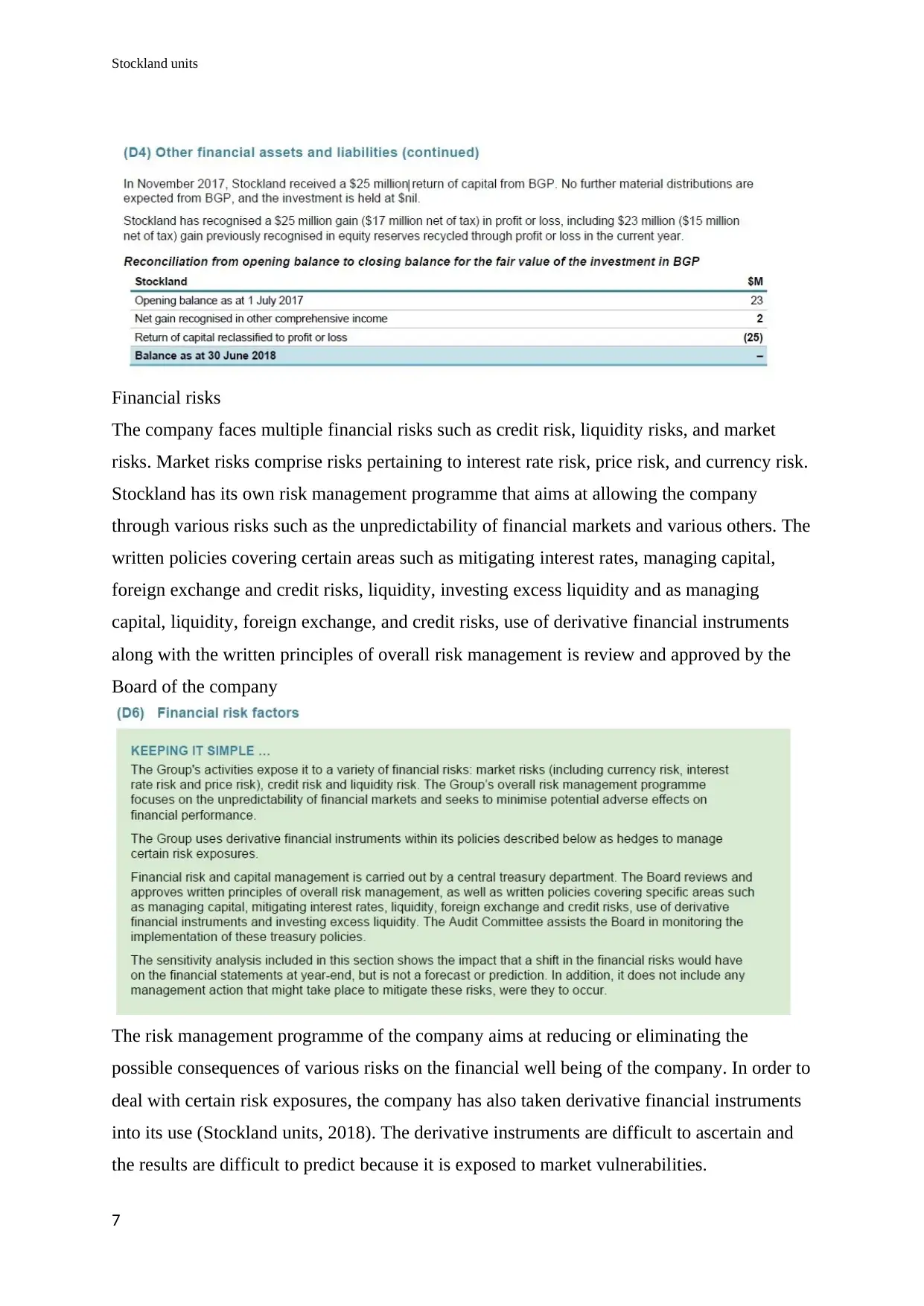
Stockland units
Financial risks
The company faces multiple financial risks such as credit risk, liquidity risks, and market
risks. Market risks comprise risks pertaining to interest rate risk, price risk, and currency risk.
Stockland has its own risk management programme that aims at allowing the company
through various risks such as the unpredictability of financial markets and various others. The
written policies covering certain areas such as mitigating interest rates, managing capital,
foreign exchange and credit risks, liquidity, investing excess liquidity and as managing
capital, liquidity, foreign exchange, and credit risks, use of derivative financial instruments
along with the written principles of overall risk management is review and approved by the
Board of the company
The risk management programme of the company aims at reducing or eliminating the
possible consequences of various risks on the financial well being of the company. In order to
deal with certain risk exposures, the company has also taken derivative financial instruments
into its use (Stockland units, 2018). The derivative instruments are difficult to ascertain and
the results are difficult to predict because it is exposed to market vulnerabilities.
7
Financial risks
The company faces multiple financial risks such as credit risk, liquidity risks, and market
risks. Market risks comprise risks pertaining to interest rate risk, price risk, and currency risk.
Stockland has its own risk management programme that aims at allowing the company
through various risks such as the unpredictability of financial markets and various others. The
written policies covering certain areas such as mitigating interest rates, managing capital,
foreign exchange and credit risks, liquidity, investing excess liquidity and as managing
capital, liquidity, foreign exchange, and credit risks, use of derivative financial instruments
along with the written principles of overall risk management is review and approved by the
Board of the company
The risk management programme of the company aims at reducing or eliminating the
possible consequences of various risks on the financial well being of the company. In order to
deal with certain risk exposures, the company has also taken derivative financial instruments
into its use (Stockland units, 2018). The derivative instruments are difficult to ascertain and
the results are difficult to predict because it is exposed to market vulnerabilities.
7
Paraphrase This Document
Need a fresh take? Get an instant paraphrase of this document with our AI Paraphraser
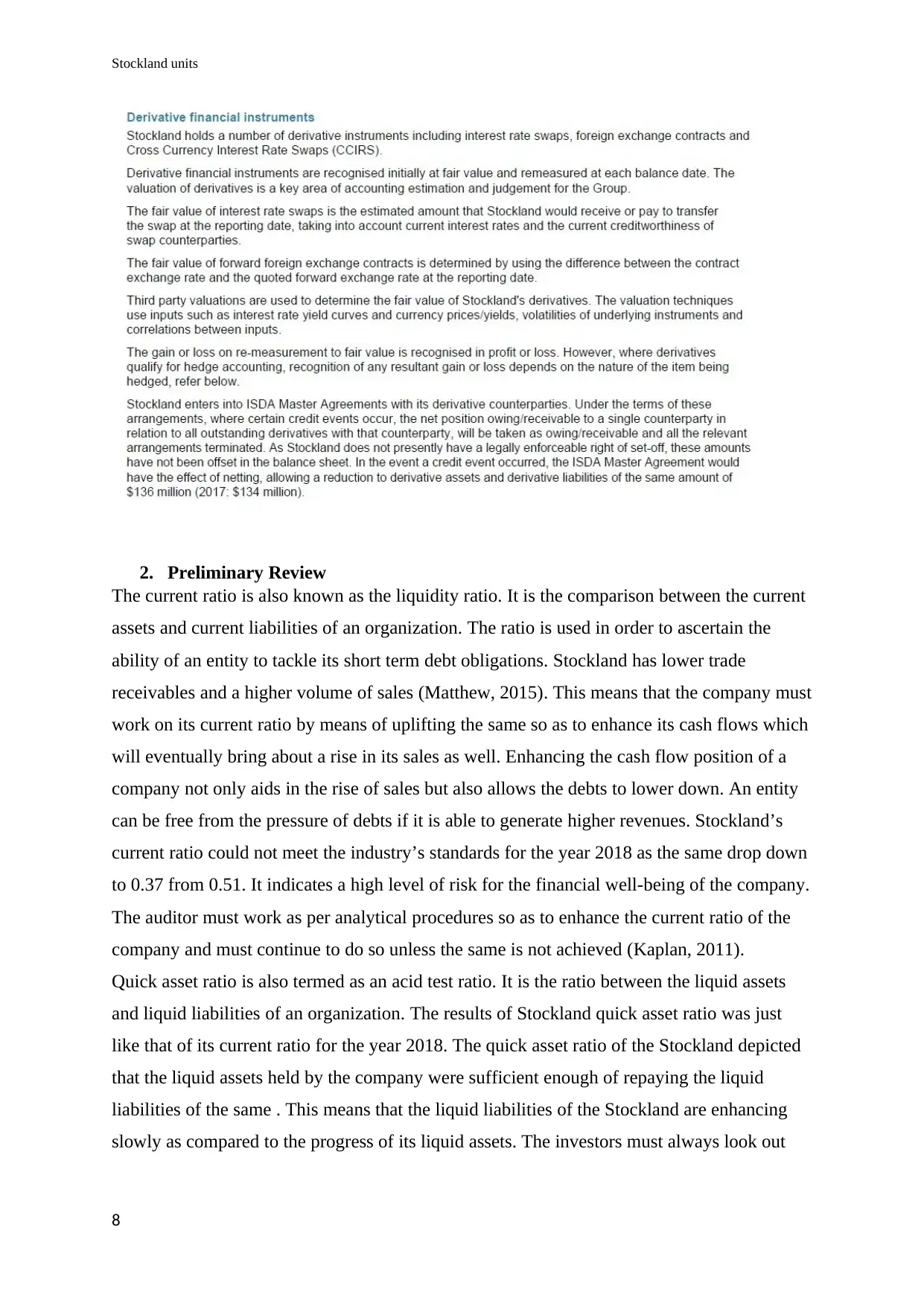
Stockland units
2. Preliminary Review
The current ratio is also known as the liquidity ratio. It is the comparison between the current
assets and current liabilities of an organization. The ratio is used in order to ascertain the
ability of an entity to tackle its short term debt obligations. Stockland has lower trade
receivables and a higher volume of sales (Matthew, 2015). This means that the company must
work on its current ratio by means of uplifting the same so as to enhance its cash flows which
will eventually bring about a rise in its sales as well. Enhancing the cash flow position of a
company not only aids in the rise of sales but also allows the debts to lower down. An entity
can be free from the pressure of debts if it is able to generate higher revenues. Stockland’s
current ratio could not meet the industry’s standards for the year 2018 as the same drop down
to 0.37 from 0.51. It indicates a high level of risk for the financial well-being of the company.
The auditor must work as per analytical procedures so as to enhance the current ratio of the
company and must continue to do so unless the same is not achieved (Kaplan, 2011).
Quick asset ratio is also termed as an acid test ratio. It is the ratio between the liquid assets
and liquid liabilities of an organization. The results of Stockland quick asset ratio was just
like that of its current ratio for the year 2018. The quick asset ratio of the Stockland depicted
that the liquid assets held by the company were sufficient enough of repaying the liquid
liabilities of the same . This means that the liquid liabilities of the Stockland are enhancing
slowly as compared to the progress of its liquid assets. The investors must always look out
8
2. Preliminary Review
The current ratio is also known as the liquidity ratio. It is the comparison between the current
assets and current liabilities of an organization. The ratio is used in order to ascertain the
ability of an entity to tackle its short term debt obligations. Stockland has lower trade
receivables and a higher volume of sales (Matthew, 2015). This means that the company must
work on its current ratio by means of uplifting the same so as to enhance its cash flows which
will eventually bring about a rise in its sales as well. Enhancing the cash flow position of a
company not only aids in the rise of sales but also allows the debts to lower down. An entity
can be free from the pressure of debts if it is able to generate higher revenues. Stockland’s
current ratio could not meet the industry’s standards for the year 2018 as the same drop down
to 0.37 from 0.51. It indicates a high level of risk for the financial well-being of the company.
The auditor must work as per analytical procedures so as to enhance the current ratio of the
company and must continue to do so unless the same is not achieved (Kaplan, 2011).
Quick asset ratio is also termed as an acid test ratio. It is the ratio between the liquid assets
and liquid liabilities of an organization. The results of Stockland quick asset ratio was just
like that of its current ratio for the year 2018. The quick asset ratio of the Stockland depicted
that the liquid assets held by the company were sufficient enough of repaying the liquid
liabilities of the same . This means that the liquid liabilities of the Stockland are enhancing
slowly as compared to the progress of its liquid assets. The investors must always look out
8
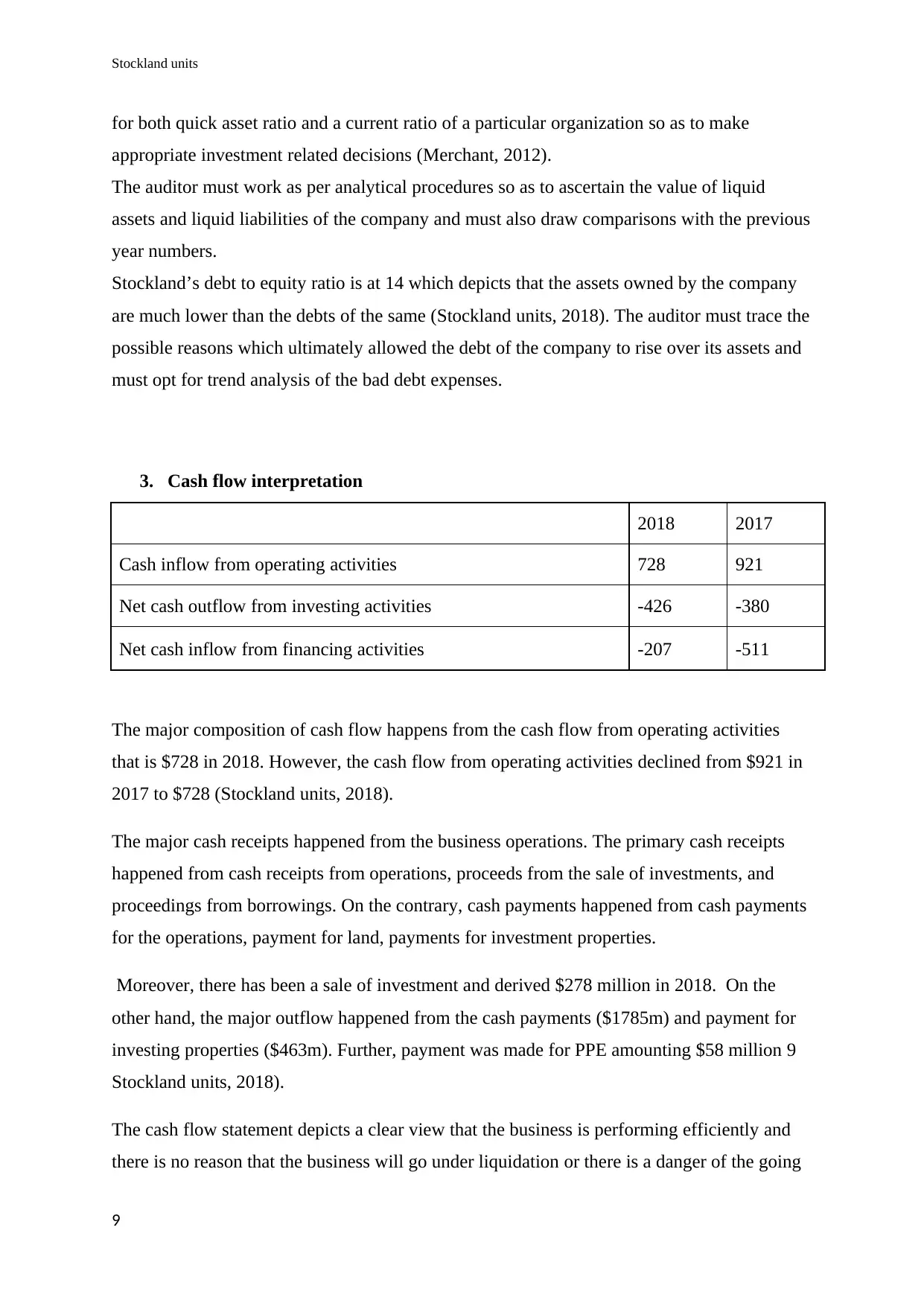
Stockland units
for both quick asset ratio and a current ratio of a particular organization so as to make
appropriate investment related decisions (Merchant, 2012).
The auditor must work as per analytical procedures so as to ascertain the value of liquid
assets and liquid liabilities of the company and must also draw comparisons with the previous
year numbers.
Stockland’s debt to equity ratio is at 14 which depicts that the assets owned by the company
are much lower than the debts of the same (Stockland units, 2018). The auditor must trace the
possible reasons which ultimately allowed the debt of the company to rise over its assets and
must opt for trend analysis of the bad debt expenses.
3. Cash flow interpretation
2018 2017
Cash inflow from operating activities 728 921
Net cash outflow from investing activities -426 -380
Net cash inflow from financing activities -207 -511
The major composition of cash flow happens from the cash flow from operating activities
that is $728 in 2018. However, the cash flow from operating activities declined from $921 in
2017 to $728 (Stockland units, 2018).
The major cash receipts happened from the business operations. The primary cash receipts
happened from cash receipts from operations, proceeds from the sale of investments, and
proceedings from borrowings. On the contrary, cash payments happened from cash payments
for the operations, payment for land, payments for investment properties.
Moreover, there has been a sale of investment and derived $278 million in 2018. On the
other hand, the major outflow happened from the cash payments ($1785m) and payment for
investing properties ($463m). Further, payment was made for PPE amounting $58 million 9
Stockland units, 2018).
The cash flow statement depicts a clear view that the business is performing efficiently and
there is no reason that the business will go under liquidation or there is a danger of the going
9
for both quick asset ratio and a current ratio of a particular organization so as to make
appropriate investment related decisions (Merchant, 2012).
The auditor must work as per analytical procedures so as to ascertain the value of liquid
assets and liquid liabilities of the company and must also draw comparisons with the previous
year numbers.
Stockland’s debt to equity ratio is at 14 which depicts that the assets owned by the company
are much lower than the debts of the same (Stockland units, 2018). The auditor must trace the
possible reasons which ultimately allowed the debt of the company to rise over its assets and
must opt for trend analysis of the bad debt expenses.
3. Cash flow interpretation
2018 2017
Cash inflow from operating activities 728 921
Net cash outflow from investing activities -426 -380
Net cash inflow from financing activities -207 -511
The major composition of cash flow happens from the cash flow from operating activities
that is $728 in 2018. However, the cash flow from operating activities declined from $921 in
2017 to $728 (Stockland units, 2018).
The major cash receipts happened from the business operations. The primary cash receipts
happened from cash receipts from operations, proceeds from the sale of investments, and
proceedings from borrowings. On the contrary, cash payments happened from cash payments
for the operations, payment for land, payments for investment properties.
Moreover, there has been a sale of investment and derived $278 million in 2018. On the
other hand, the major outflow happened from the cash payments ($1785m) and payment for
investing properties ($463m). Further, payment was made for PPE amounting $58 million 9
Stockland units, 2018).
The cash flow statement depicts a clear view that the business is performing efficiently and
there is no reason that the business will go under liquidation or there is a danger of the going
9
⊘ This is a preview!⊘
Do you want full access?
Subscribe today to unlock all pages.

Trusted by 1+ million students worldwide
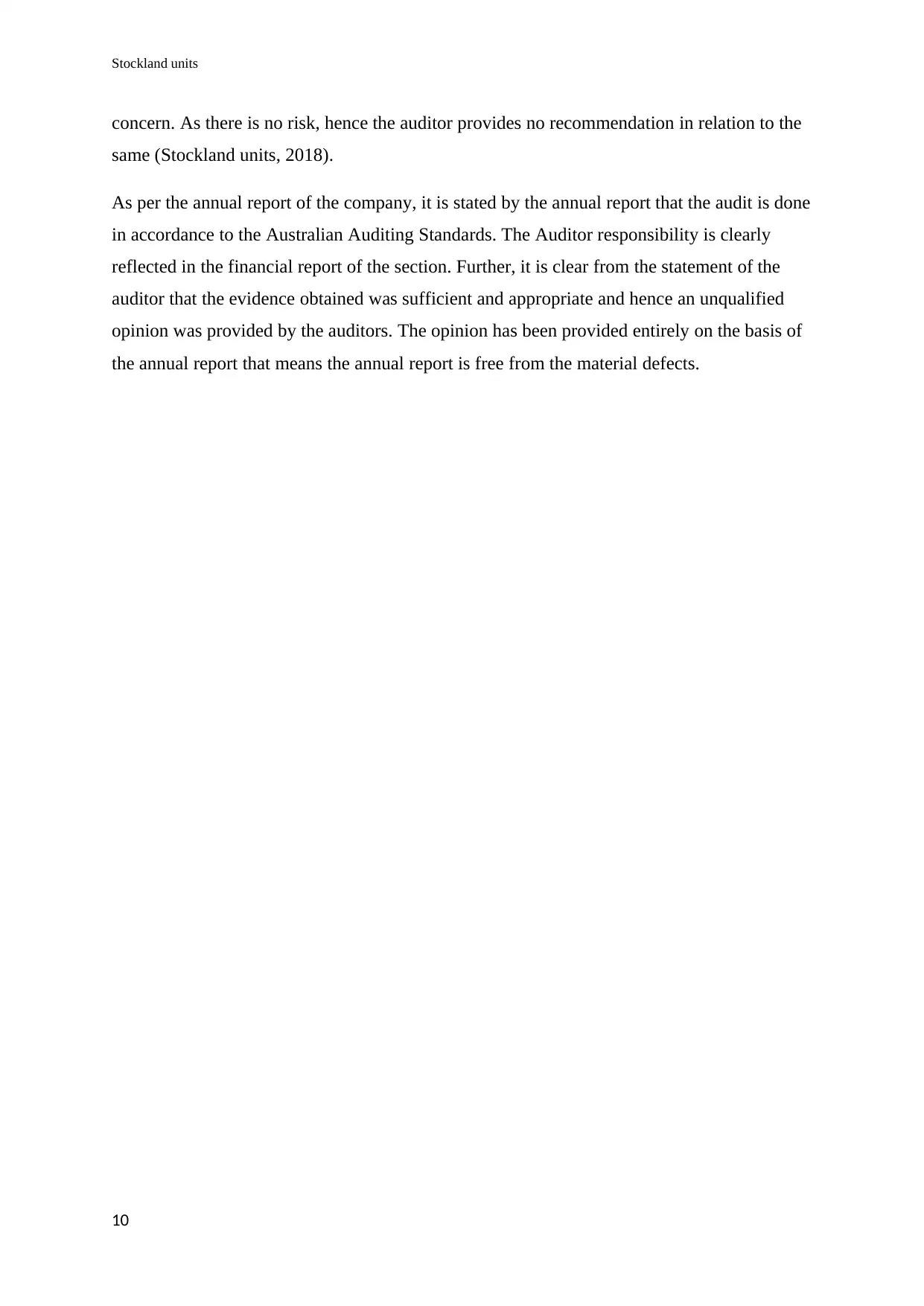
Stockland units
concern. As there is no risk, hence the auditor provides no recommendation in relation to the
same (Stockland units, 2018).
As per the annual report of the company, it is stated by the annual report that the audit is done
in accordance to the Australian Auditing Standards. The Auditor responsibility is clearly
reflected in the financial report of the section. Further, it is clear from the statement of the
auditor that the evidence obtained was sufficient and appropriate and hence an unqualified
opinion was provided by the auditors. The opinion has been provided entirely on the basis of
the annual report that means the annual report is free from the material defects.
10
concern. As there is no risk, hence the auditor provides no recommendation in relation to the
same (Stockland units, 2018).
As per the annual report of the company, it is stated by the annual report that the audit is done
in accordance to the Australian Auditing Standards. The Auditor responsibility is clearly
reflected in the financial report of the section. Further, it is clear from the statement of the
auditor that the evidence obtained was sufficient and appropriate and hence an unqualified
opinion was provided by the auditors. The opinion has been provided entirely on the basis of
the annual report that means the annual report is free from the material defects.
10
Paraphrase This Document
Need a fresh take? Get an instant paraphrase of this document with our AI Paraphraser
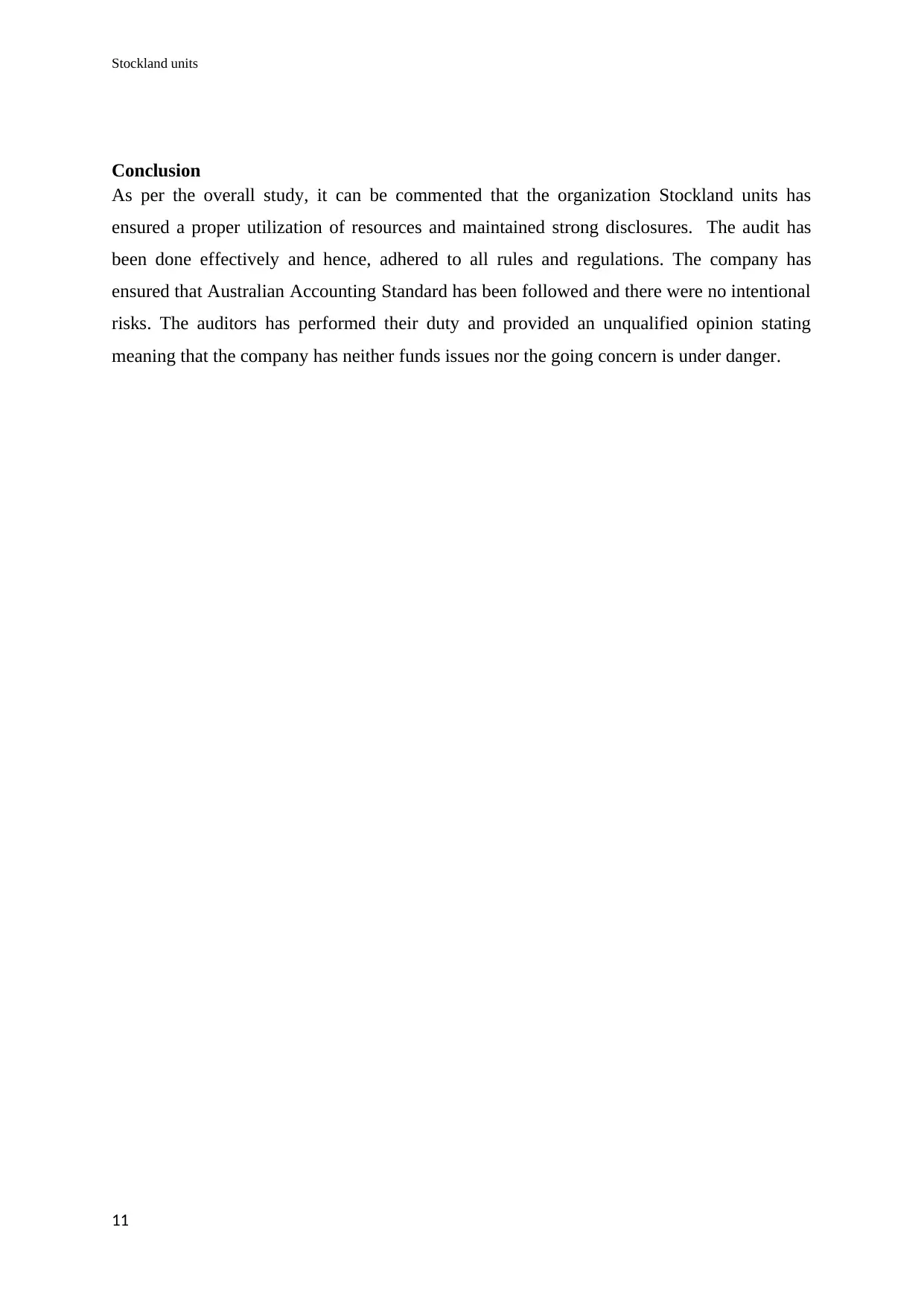
Stockland units
Conclusion
As per the overall study, it can be commented that the organization Stockland units has
ensured a proper utilization of resources and maintained strong disclosures. The audit has
been done effectively and hence, adhered to all rules and regulations. The company has
ensured that Australian Accounting Standard has been followed and there were no intentional
risks. The auditors has performed their duty and provided an unqualified opinion stating
meaning that the company has neither funds issues nor the going concern is under danger.
11
Conclusion
As per the overall study, it can be commented that the organization Stockland units has
ensured a proper utilization of resources and maintained strong disclosures. The audit has
been done effectively and hence, adhered to all rules and regulations. The company has
ensured that Australian Accounting Standard has been followed and there were no intentional
risks. The auditors has performed their duty and provided an unqualified opinion stating
meaning that the company has neither funds issues nor the going concern is under danger.
11
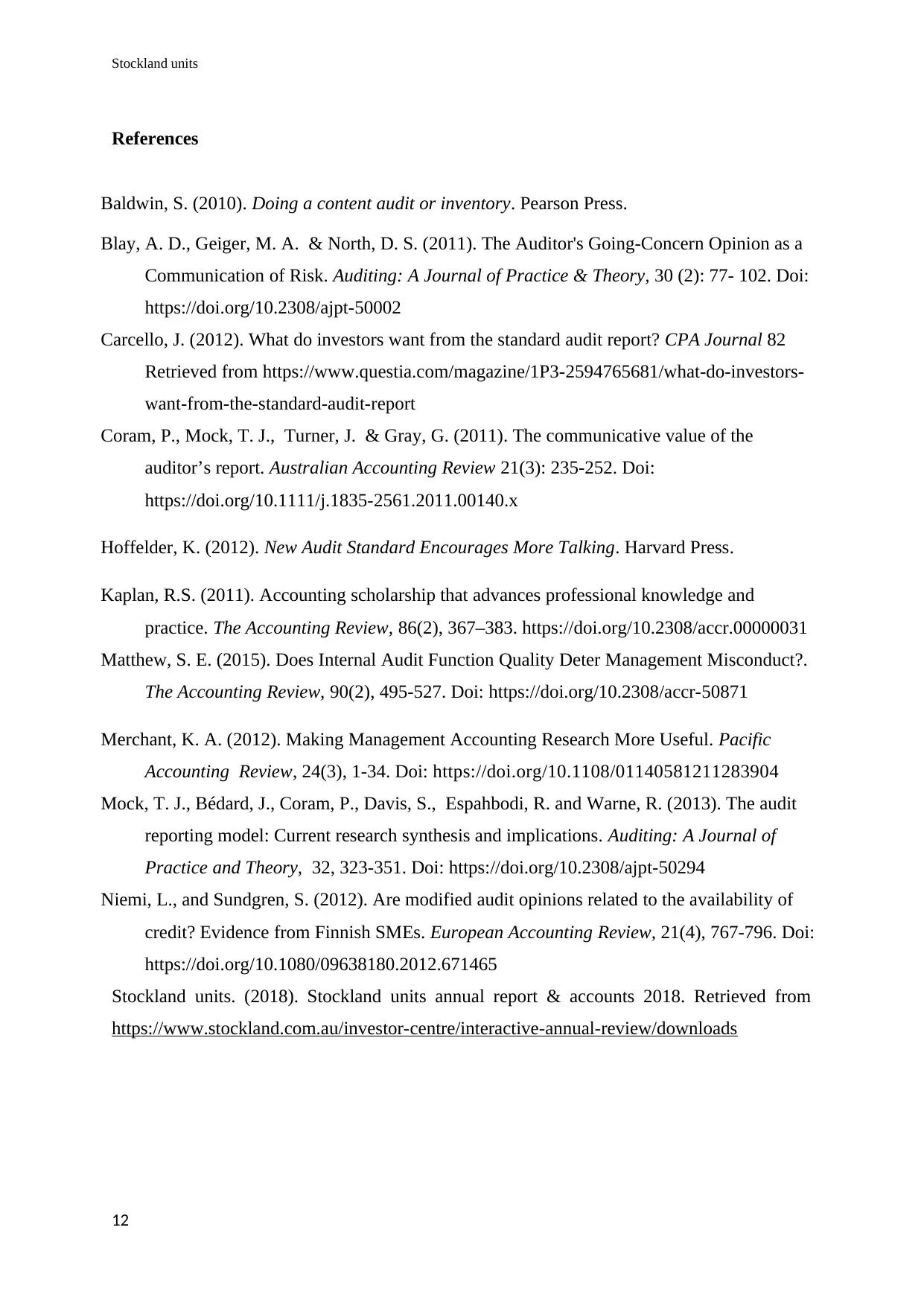
Stockland units
References
Baldwin, S. (2010). Doing a content audit or inventory. Pearson Press.
Blay, A. D., Geiger, M. A. & North, D. S. (2011). The Auditor's Going-Concern Opinion as a
Communication of Risk. Auditing: A Journal of Practice & Theory, 30 (2): 77- 102. Doi:
https://doi.org/10.2308/ajpt-50002
Carcello, J. (2012). What do investors want from the standard audit report? CPA Journal 82
Retrieved from https://www.questia.com/magazine/1P3-2594765681/what-do-investors-
want-from-the-standard-audit-report
Coram, P., Mock, T. J., Turner, J. & Gray, G. (2011). The communicative value of the
auditor’s report. Australian Accounting Review 21(3): 235-252. Doi:
https://doi.org/10.1111/j.1835-2561.2011.00140.x
Hoffelder, K. (2012). New Audit Standard Encourages More Talking. Harvard Press.
Kaplan, R.S. (2011). Accounting scholarship that advances professional knowledge and
practice. The Accounting Review, 86(2), 367–383. https://doi.org/10.2308/accr.00000031
Matthew, S. E. (2015). Does Internal Audit Function Quality Deter Management Misconduct?.
The Accounting Review, 90(2), 495-527. Doi: https://doi.org/10.2308/accr-50871
Merchant, K. A. (2012). Making Management Accounting Research More Useful. Pacific
Accounting Review, 24(3), 1-34. Doi: https://doi.org/10.1108/01140581211283904
Mock, T. J., Bédard, J., Coram, P., Davis, S., Espahbodi, R. and Warne, R. (2013). The audit
reporting model: Current research synthesis and implications. Auditing: A Journal of
Practice and Theory, 32, 323-351. Doi: https://doi.org/10.2308/ajpt-50294
Niemi, L., and Sundgren, S. (2012). Are modified audit opinions related to the availability of
credit? Evidence from Finnish SMEs. European Accounting Review, 21(4), 767-796. Doi:
https://doi.org/10.1080/09638180.2012.671465
Stockland units. (2018). Stockland units annual report & accounts 2018. Retrieved from
https://www.stockland.com.au/investor-centre/interactive-annual-review/downloads
12
References
Baldwin, S. (2010). Doing a content audit or inventory. Pearson Press.
Blay, A. D., Geiger, M. A. & North, D. S. (2011). The Auditor's Going-Concern Opinion as a
Communication of Risk. Auditing: A Journal of Practice & Theory, 30 (2): 77- 102. Doi:
https://doi.org/10.2308/ajpt-50002
Carcello, J. (2012). What do investors want from the standard audit report? CPA Journal 82
Retrieved from https://www.questia.com/magazine/1P3-2594765681/what-do-investors-
want-from-the-standard-audit-report
Coram, P., Mock, T. J., Turner, J. & Gray, G. (2011). The communicative value of the
auditor’s report. Australian Accounting Review 21(3): 235-252. Doi:
https://doi.org/10.1111/j.1835-2561.2011.00140.x
Hoffelder, K. (2012). New Audit Standard Encourages More Talking. Harvard Press.
Kaplan, R.S. (2011). Accounting scholarship that advances professional knowledge and
practice. The Accounting Review, 86(2), 367–383. https://doi.org/10.2308/accr.00000031
Matthew, S. E. (2015). Does Internal Audit Function Quality Deter Management Misconduct?.
The Accounting Review, 90(2), 495-527. Doi: https://doi.org/10.2308/accr-50871
Merchant, K. A. (2012). Making Management Accounting Research More Useful. Pacific
Accounting Review, 24(3), 1-34. Doi: https://doi.org/10.1108/01140581211283904
Mock, T. J., Bédard, J., Coram, P., Davis, S., Espahbodi, R. and Warne, R. (2013). The audit
reporting model: Current research synthesis and implications. Auditing: A Journal of
Practice and Theory, 32, 323-351. Doi: https://doi.org/10.2308/ajpt-50294
Niemi, L., and Sundgren, S. (2012). Are modified audit opinions related to the availability of
credit? Evidence from Finnish SMEs. European Accounting Review, 21(4), 767-796. Doi:
https://doi.org/10.1080/09638180.2012.671465
Stockland units. (2018). Stockland units annual report & accounts 2018. Retrieved from
https://www.stockland.com.au/investor-centre/interactive-annual-review/downloads
12
⊘ This is a preview!⊘
Do you want full access?
Subscribe today to unlock all pages.

Trusted by 1+ million students worldwide
1 out of 15
Related Documents
Your All-in-One AI-Powered Toolkit for Academic Success.
+13062052269
info@desklib.com
Available 24*7 on WhatsApp / Email
![[object Object]](/_next/static/media/star-bottom.7253800d.svg)
Unlock your academic potential
Copyright © 2020–2025 A2Z Services. All Rights Reserved. Developed and managed by ZUCOL.





